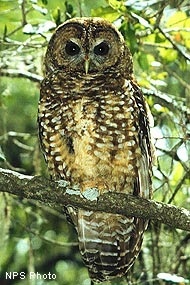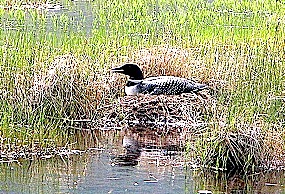The calendar may say it’s still technically summer, but where I live in northern Michigan the sugar maples are already showing some autumn color. These first cool nights remind us that it’s time to make preparations for the coming winter. Make sure the heating oil tank is full, the snow-blower operational, and winter tires on the car.
Our avian friends may have a better idea (as do many retired Americans); they get out of town! Birders all over the country welcome fall migration as a relief from late summer, which is really the “winter” of the bird-watching hobby when almost no one is migrating and very few resident birds are singing or prominently defending nesting territory. There just isn’t much action in July and August.
Why not celebrate fall migration with a trip to a national park, or just incorporate some birding into the trip you’ve already planned? In the spring, you can almost use bird migration as a calendar.
The different species arrive at predictable times and often in relatively organized flocks. Autumn is a much more disjointed affair. Migration through the year is somewhat like a wild party. Everyone arrives looking sharp as soon as the day’s chores end, but later they all stagger home, disheveled and unrecognizable, over the course of the night and following morning. (At least that’s how it went when I was in college.) Birds in the fall are often wearing different colors than they were several months earlier, and their timing seems random.

Spotted owls can often be spotted at Point Reyes National Seashore. NPS photo.
Hawks and other raptors, however, are the exception to that trend. The fall migration of hawks is legendary, with huge lines of hundreds or even thousands of birds heading south over well-established flyways. It’s a good bet that if you live in the northern parts of the country or along any coast, there’s a hawk-watching event within a day’s drive of your home.
For my money, I’d put some of America’s finest mountain scenery in the background and head off to Washington to watch raptors heading south from Alaska. North Cascades National Park, along with Ross Lake and Lake Chelan National Recreation Areas, sits along the path birds of prey like the sharp-shinned hawk follow en route to the subtropics from nesting grounds in Alaska.
Just outside the park complex, you’ll find some folks with eyes skyward at the second annual Chelan Ridge Hawk Migration Festival. Migrating raptors often rely on thermals, following ridge-lines in areas like the North Cascades looking for free rides from these columns of warm air rising from the heated surface of the earth.
Pick a spot in the mountains this month on a sunny day and watch them soar past. If going to the shore is more your thing, check out Fall Migration at the Point on October 1st at Point Reyes National Seashore. This weekend event includes an overnight stay at the Historic Lifeboat Station at Chimney Rock and the chance to see a dizzying array of migrating warblers, sparrows, and other songbirds. Four-hundred-and-ninety different species of birds have been spotted at Point Reyes, making it the unofficial champion of bird diversity in the National Park System.
The peninsula is a geographic magnet of sorts when it comes to birds on the Pacific flyway. The shore itself attracts a wide variety of fowl, shorebirds, and waterbirds with rarities often showing up.
The seashores on the Atlantic side don’t miss out on the migration party. Gateway National Recreation Area, Cape Lookout National Seashore, and Cape Hatteras National Seashore are well-known stops on the Atlantic flyway.

Loons are common at Acadia National Park. Kirby Adams photo.
Unfortunately, we saw this summer that these areas are also occasionally in the path of destructive hurricanes. The damage caused by Hurricane Irene has rendered many parts of these parks inaccessible.
Avid birders can be a little zealous at times, but for personal safety and to avoid interfering with clean-up efforts, everyone needs to be particularly conscientious about birding these parks this fall.
Further south, Cumberland Island National Seashore was spared the wrath of the storm this time. Cumberland Island is known for its huge flocks of thousands of migrating tree swallows. The beach and grassy dunes can be blackened with these energetic little jet-fighter look-alikes during October.
Cumberland also boasts 32 species of warblers, some of which migrate through and some that find it a suitable spot to stay the winter. With all this bird activity on a prominent barrier island, there are also frequent visits from migrating peregrine falcons that like to chase and feast upon songbirds. Cumberland Island in October is essentially a falcon smorgasbord.
Birds aren’t the only animals migrating in the autumn. I know of few birders that don’t also appreciate, if not actively follow, butterflies as well. The massing and migration of Monarch Butterflies is a celebrated spectacle at their wintering grounds in the mountains of Mexico. You can see them start their journey during a ranger-led hike in Cuyahoga Valley National Park on September 18th. This is just a day after the park’s annual Fall Bird Census when volunteers can assist ornithologists with a count of migrating birds.
These are just two of several fall migration and birding programs at Cuyahoga Valley.
Even if you’re new to the hobby, birding festivals, field trips, and ranger-led walks and programs are a great way to introduce yourself to the world of bird-watching. In fact, it may be the best way. These events are full of experienced birders that are always eager to help a beginner spot some life birds.
You learn best by doing, so get out to a national park this autumn and join some other travelers for the fall migration.


 Support Essential Coverage of Essential Places
Support Essential Coverage of Essential Places







Comments
Looking forward to it!